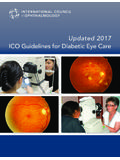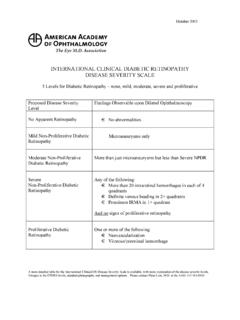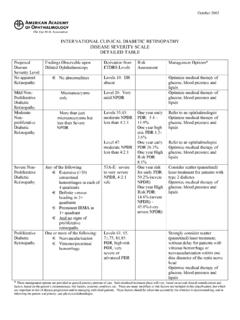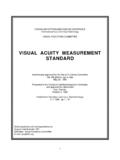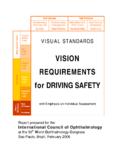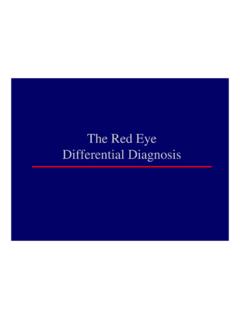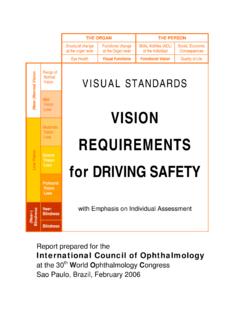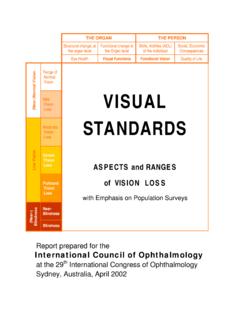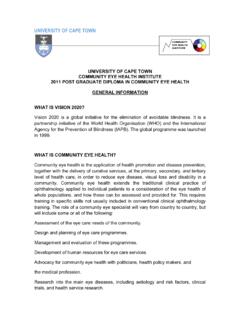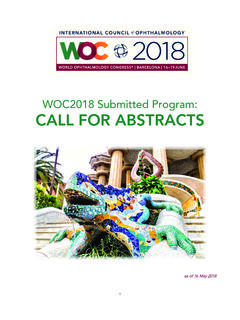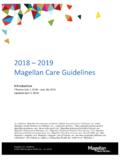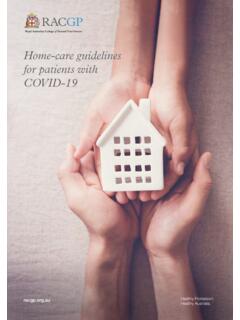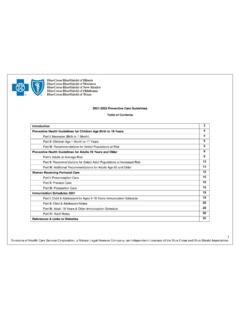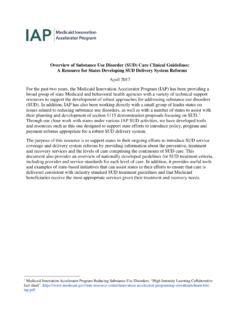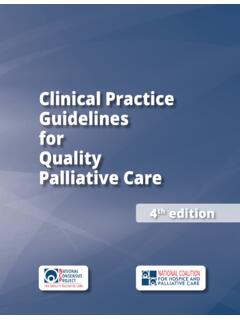Transcription of ICO Guidelines for Glaucoma Eye Care
1 ICO Guidelines for Glaucoma Eye CareInternational Council of Ophthalmology Guidelines for Glaucoma Eye CareThe International Council of Ophthalmology (ICO) Guidelines for Glaucoma Eye care have been developed as a supportive and educational resource for ophthalmologists and eye care providers worldwide. The goal is to improve the quality of eye care for patients and to reduce the risk of vision loss from the most common forms of open and closed angle Glaucoma around the world. Core requirements for the appropriate care of open and closed angle Glaucoma have been summarized, and consider low and intermediate to high resource settings. This is the first edition of the ICO Guidelines for Glaucoma Eye care (February 2016). They are designed to be a working document to be adapted for local use, and we hope that the Guidelines are easy to read and Task Force for Glaucoma Eye CareNeeru Gupta, MD, PhD, MBA, ChairmanTin Aung, MBBS, PhDNathan Congdon, MD Tanuj Dada, MDFabian Lerner, MDSola Olawoye, MDSerge Resnikoff, MD, PhDNingli Wang, MD, PhD Richard Wormald, MDAcknowledgementsWe gratefully acknowledge Dr.
2 Ivo Kocur, Medical Officer, Prevention of Blindness, World Health Organization (WHO), Geneva, Switzerland, for his invaluable input and participation in the discussions of the Task Force. We sincerely thank Professor Hugh Taylor, ICO President, Melbourne, Australia, for many helpful insights during the development of these Council of Ophthalmology | Guidelines for Glaucoma Eye care International Council of Ophthalmology | Guidelines for Glaucoma Eye CareTable of ContentsIntroduction 2 Initial clinical Assessment of Glaucoma 4 Glaucoma Assessment and Equipment Needs 5 Glaucoma Assessment Checklist 6 Approach to Open Angle Glaucoma care 10 Ongoing Open Angle Glaucoma care 13 Approach to Closed Angle Glaucoma care 15 Ongoing care for Closed Angle Glaucoma 16 Indicators to Assess Glaucoma care Programs 19 ICO Guidelines for Glaucoma Eye care 20 International Council of Ophthalmology | Guidelines for Glaucoma Eye care | Page 1 IntroductionGlaucoma is the leading cause of world blindness after cataracts.
3 Glaucoma refers to a group of diseases, in which optic nerve damage is the common pathology that leads to vision loss. The most common types of Glaucoma are open angle and closed angle forms. Worldwide, open angle and closed angle Glaucoma each account for about half of all Glaucoma cases. Together, they are the major cause of irreversible vision loss globally. The burden of each of these diseases varies considerably among racial and ethnic groups worldwide. For example, in western countries, vision loss from open angle Glaucoma is most common, in contrast to East Asia, where vision loss from closed angle Glaucoma is most common. Patients with Glaucoma are reported to have poorer quality of life, reduced levels of physical, emotional, and social well-being, and utilize more health care intraocular pressure (IOP) is a major risk factor for loss of sight from both open and closed angle Glaucoma , and the only one that is modifiable.
4 The risk of blindness depends on the height of the intraocular pressure, severity of disease, age of onset, and other determinants of susceptibility, such as family history of Glaucoma . Epidemiological studies and clinical trials have shown that optimal control of IOP reduces the risk of optic nerve damage and slows disease progression. Lowering IOP is the only intervention proven to prevent the loss of sight from Glaucoma . Glaucoma should be ruled out as part of every regular eye examination, since complaints of vision loss may not be present. Differentiating open from closed angle Glaucoma is essential from a therapeutic standpoint, because each form of the disease has unique management considerations and interventions. Once the correct diagnosis of open or closed angle Glaucoma has been made, appropriate steps can be taken through medications, laser, and microsurgery.
5 This approach can prevent severe vision loss and disability from sight threatening low resource settings, managing patients with Glaucoma has unique challenges. Inability to pay, treatment rejection, poor compliance, and lack of education and awareness, are all barriers to good Glaucoma care . Most patients are unaware of Glaucoma disease, and by the time they present, many have lost significant vision. Long distances from healthcare facilities, and insufficient medical professionals and equipment, add to the difficulty in treating Glaucoma . A diagnosis of open or closed angle Glaucoma requires medical and surgical interventions to prevent vision loss and to preserve quality of life. Preventing Glaucoma blindness in underserved regions requires heightened attention to local educational needs, availability of expertise, and basic infrastructure requirements.
6 There is strong support to integrate Glaucoma care within comprehensive eye care programs and to consider rehabilitation aspects of care . Persistent efforts to support effective and accessible care for Glaucoma are Universal Eye Health: A Global Action Plan 2014-2019, WHO, 2013 Council of Ophthalmology | Guidelines for Glaucoma Eye care | Page 2 Open Angle GlaucomaIn open angle Glaucoma , there is characteristic optic nerve damage and loss of visual function in the presence of an open angle with no identifying pathology. The disease is chronic and progressive. Although elevated IOP is often associated with the disease, elevated IOP is not necessary to make the diagnosis. Risk factors for the disease include elevated intraocular pressure, increasing age, positive family history, racial background, myopia, thin corneas, hypertension, and diabetes.
7 Patients with elevated IOP or other risk factors should be followed regularly for the development of patients with open and closed angle forms of Glaucoma are unaware they have sight-threatening disease. Mass population screening is not currently recommended. However, all patients presenting for eye care should be reviewed for Glaucoma risk factors and undergo clinical examination to rule out Glaucoma . Patients with Glaucoma should be told to alert brothers, sisters, parents, sons, and daughters that they have a higher risk of developing disease, and that they also need to be checked regularly for Glaucoma . The ability to make an accurate diagnosis of Glaucoma , to determine whether it is an open or closed form, and to assess disease severity and stability, are essential to Glaucoma care strategies and blindness prevention.
8 Open Angle Glaucomatous Optic Nerve Damage Elevated IOP Visual Field Damage Closed Angle Elevated IOP Glaucomatous Optic Nerve Damage Visual Field DamageClosed Angle GlaucomaIn closed angle Glaucoma , optic nerve damage and vision loss may occur in the presence of an anatomical block of the anterior chamber angle by the iris. This may lead to elevated intraocular pressure and optic nerve damage. In acute angle closure Glaucoma , the disease may be painful, needing emergency care . More often the disease is chronic, progressive, and without symptoms. Risk factors for the disease include racial background, increasing age, female gender, positive family history, and hyperopia. Patients with these risk factors should be followed regularly for the development of closed angle Council of Ophthalmology | Guidelines for Glaucoma Eye care | Page 3 Initial clinical Assessment of GlaucomaHistory Assessment for Glaucoma includes asking about complaints that may relate to Glaucoma such as vision loss, pain, redness, and halos around lights.
9 The onset, duration, location, and severity of symptoms should be noted. All patients should be asked about family members with Glaucoma , and a detailed history should also be 1 - History ChecklistInitial Glaucoma AssessmentEvaluation for Glaucoma is recommended as part of a comprehensive eye exam. The ability to diagnose Glaucoma in its open or closed angle forms, and to evaluate its severity, are critical to Glaucoma care approaches and the prevention of blindness. Core examination and equipment needs to diagnose and monitor Glaucoma patients are listed in Table 2. Chief Complaint Age, Race, Occupation Social History Possibility of Pregnancy Family History of Glaucoma Past Eye Disease, Surgery, or Trauma Corticosteroid Use Eye Medications Systemic Medications Drug Allergies Tobacco, Alcohol, Drug Use Diabetes Lung Disease Heart Disease Cerebrovascular Disease Hypertension/Hypotension Renal Stones Migraine Raynaud's Disease Review of SystemsInternational Council of Ophthalmology | Guidelines for Glaucoma Eye care | Page 4 Table 2 - Glaucoma Assessment and Equipment Needs - International Recommendations clinical AssessmentMinimal Equipment (Low Resource Settings)Optional Equipment (Intermediate / High Resource Settings)
10 Visual AcuityNear reading card or distance chart with 5 standard letters or symbolsPinhole 3- or 4-meter visual acuity lane with high contrast visual acuity chartRefractionTrial frame and lensesRetinoscope, Jackson cross-cylinderPhoropterAutorefractorPupi lsPen light or torch Anterior Segment Slit lamp biomicroscope KeratometerCorneal pachymeterIntraocular Pressure Goldmann applanation tonometer Portable handheld applanation t onometer Schiotz tonometerTonopenPneumotonometerAngle StructuresSlit lamp gonioscopy Goldmann, Zeiss/Posner goniolensesAnterior segment optical coherence tomography Ultrasound biomicroscopy Optic Nerve (dilated if angle open)Direct ophthalmoscopeSlit lamp biomicroscopy with hand held 78 or 90 diopter lensFundus photographyOptic nerve image analyzers Confocal scanning laser ophthalmoscopy Optical coherence tomography Scanning laser polarimetryFundus Direct ophthalmoscopeHead mounted indirect ophthalmoscope with 20 or 25 diopter lensSlit lamp biomicroscopy with 78 diopter lens12 and 30 diopter lenses60 and 90 diopter lensesVisual FieldManual perimetry or automated white on white perimetryFrequency doubling technologyShort wave automated perimetry International Council of Ophthalmology | Guidelines for Glaucoma Eye care | Page 5 Visual Acuity Vision should be tested (undilated), unaided, and with best correction at distance and near.
